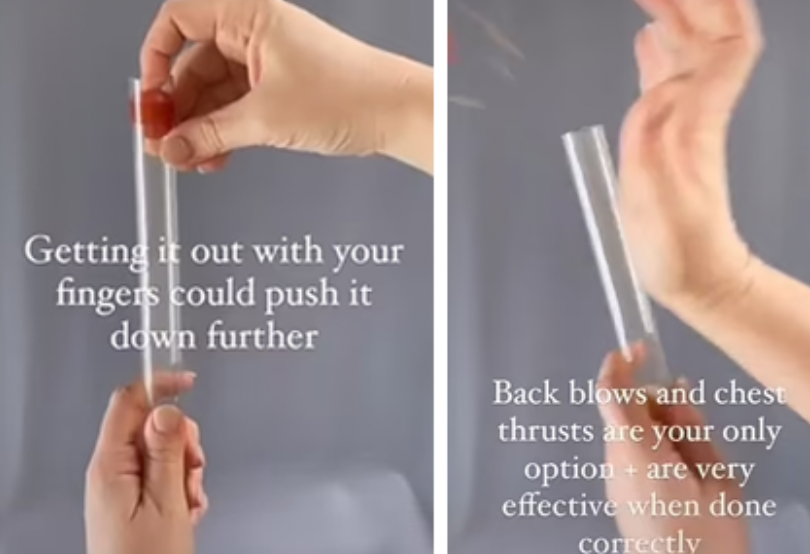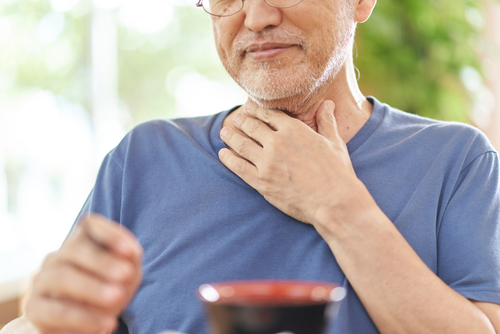Why you should NEVER stick your fingers in your grandchild's mouth if they're choking, according to a paramedic
- Replies 4
A grandparent's worst nightmare is likely their young grandchild choking on a piece of food or toy. Given that choking is one of the most common accidents in which young children are hospitalised in Australia every year, this is a valid concern.
That is why it's so important for us to be as prepared as possible in case it does happen.
While most of us are familiar with the back blows and chest thrusts technique, there's one other very important thing to remember – never stick your fingers down your child's throat!
This little-known fact was recently shared by paramedic Nikki Jurcutz in a TikTok video demonstration. As she explained, trying to remove the item with your fingers could actually push it further down and make the situation even worse.

When a grandchild is choking, getting the obstruction out with your fingers may do more harm than good. Credit: TikTok.
Instead of using your fingers, Ms Jurcutz recommends that back blows and chest thrusts are still the most effective options when it comes to rescuing a child who's choking.
Ms Jurcutz explained using a plastic tube, which is reportedly the size of a toddler's airway. 'If your little one has a complete obstruction, no air can get in or out,' she said.
'Getting it out with your fingers could push it down further. Back blows and chest thrusts are your only option and are very effective when done properly.'
Ms Jurcutz's video quickly went viral on social media, with many fellow parents and grandparents expressing their gratitude for her informative demonstration.
One user wrote in the comments section: 'This is such a great demonstration of why this is the best method, thank you,' while another said: 'For the first time, I've clearly understood the manoeuvre required due to this brilliant demo. Thank you.'
Others took the opportunity to share their own 'traumatic' experiences with choking, with one person sharing: 'I once choked for like two seconds. It honestly was traumatising enough. I felt the panic and fear wash over me. Always cut the food for children…'
Another user advised people to always cut fruits into quarters: 'Cut in quarters and lengthwise quarters. You can get away with halves for most blueberries and raspberries.'
Even though it's true that grandchildren, especially toddlers, are more likely to choke on something, adults still need to exercise caution. Hospitalisations from choking and suffocating are higher among young children, but fatalities are highest among the elderly.
When someone is choking, their life is in danger. That's why it's important to know the basic first aid for choking, as it can save the life of a person who is choking if it's done right away.
The first thing to do if you come across someone who is choking is to tell them to breathe and cough, as recommended by Better Health. If clearing the obstruction with coughing doesn't work:

Older adults are prone to choking too. Credit: Shutterstock. (Stock photo)
And if you are the one choking:
Credit: Fluid First Aid.
That is why it's so important for us to be as prepared as possible in case it does happen.
While most of us are familiar with the back blows and chest thrusts technique, there's one other very important thing to remember – never stick your fingers down your child's throat!
This little-known fact was recently shared by paramedic Nikki Jurcutz in a TikTok video demonstration. As she explained, trying to remove the item with your fingers could actually push it further down and make the situation even worse.
When a grandchild is choking, getting the obstruction out with your fingers may do more harm than good. Credit: TikTok.
Instead of using your fingers, Ms Jurcutz recommends that back blows and chest thrusts are still the most effective options when it comes to rescuing a child who's choking.
Ms Jurcutz explained using a plastic tube, which is reportedly the size of a toddler's airway. 'If your little one has a complete obstruction, no air can get in or out,' she said.
'Getting it out with your fingers could push it down further. Back blows and chest thrusts are your only option and are very effective when done properly.'
Ms Jurcutz's video quickly went viral on social media, with many fellow parents and grandparents expressing their gratitude for her informative demonstration.
One user wrote in the comments section: 'This is such a great demonstration of why this is the best method, thank you,' while another said: 'For the first time, I've clearly understood the manoeuvre required due to this brilliant demo. Thank you.'
Others took the opportunity to share their own 'traumatic' experiences with choking, with one person sharing: 'I once choked for like two seconds. It honestly was traumatising enough. I felt the panic and fear wash over me. Always cut the food for children…'
Another user advised people to always cut fruits into quarters: 'Cut in quarters and lengthwise quarters. You can get away with halves for most blueberries and raspberries.'
Even though it's true that grandchildren, especially toddlers, are more likely to choke on something, adults still need to exercise caution. Hospitalisations from choking and suffocating are higher among young children, but fatalities are highest among the elderly.
When someone is choking, their life is in danger. That's why it's important to know the basic first aid for choking, as it can save the life of a person who is choking if it's done right away.
The first thing to do if you come across someone who is choking is to tell them to breathe and cough, as recommended by Better Health. If clearing the obstruction with coughing doesn't work:
- Call triple zero (000).
- Bend the person well forward and give five back blows with the heel of your hand between their shoulder blades – checking if the blockage has been removed after each blow.
- If unsuccessful, give five chest thrusts by placing one hand in the middle of their back for support and the heel of the other hand on the lower part of their breastbone – checking if the blockage has been removed after each thrust.
Older adults are prone to choking too. Credit: Shutterstock. (Stock photo)
And if you are the one choking:
- Try to stay calm. Attract someone’s attention for help.
- Attempt forceful coughing. Lean as far forward as you can. Hold onto something that is firmly anchored, if possible. Breathe out and then take a deep breath in and cough. This may eject the foreign object.
- Don’t let anyone slap you on the back while you are upright. Gravity may cause the object to slip further down your trachea (windpipe).
Credit: Fluid First Aid.







